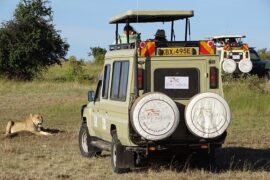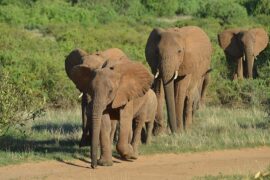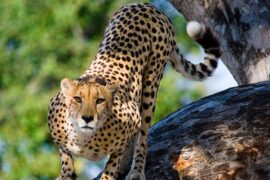Maasai Mara National Reserve
A Kenya safari showcasing ‘The Greatest Wildlife Show on Earth’
World renowned for the breathtaking spectacle of ‘the greatest wildlife show on earth’, the awe inspiring annual wildebeest migration, the Masai Mara National Reserve is Kenya’s most visited wildlife protected area.
Technically an extension of Tanzania’s renowned Serengeti National Park, the Mara constitutes only 4% of the entire Serengeti ecosystem but its rolling grasslands, meandering rivers and towering escarpments offer one of the world’s most rewarding and evocative African safari wildlife arenas.
Fact File
Altitude: 1,500-2,170 meters above sea level.
Area: 1, 672 sq km.
Location: Rift Valley Province, Narok and Transmara Districts.
Distance from Nairobi: 270 km270 kilometers from Nairobi, and takes about 4 to 5 hours by road. There are scheduled flights, twice daily from Wilson Airport Nairobi, which take about 40 – 45 minutes.
Climate
The Reserve receives the highest rainfall (average 1000 mm pa) in the Serengeti-Mara ecosystem. Rain falls throughout the year but peaks in December, January and April.
Vegetation
Comprises open rolling grassland, riverine forest, acacia woodland, swamps, non-deciduous thickets, and Acacia, Croton and Tarchonanthus scrub.
Wildebeest Migration
Between the end of July and November, over one and a half million wildebeest accompanied by half again as many zebras and gazelles, migrate from the short-grass plains of the Serengeti to fresh pasture in the grasslands of the Mara; thus creating one of nature’s grandest spectacles.
Moving in groups of up to 20,000 at a time they thunder across the plateau hesitating only briefly to cross the Mara River, where many fall prey to the waiting crocodiles.
Towards the end of October they begin crossing back into Tanzania. The actual timing of the migration, however, is dictated by the weather and does not always run to schedule.
Best Time to Visit
With the wildebeest migration in July to October, this is the best time to see these incredible movement of animals.
Although it is not guaranteed that the wildebeest get to Maasai Mara, it has yet to let us down. Also, December to February are great times as it is dryer, however the wildebeest and a lot of the zebra will have moved on to the Serengeti National Park in Tanzania by then.
Wildlife
Historically teaming with wildlife, the Mara is famous for the large herds of elephant and buffalo that meander its plains; also for the fat pods of hippo that wallow in its mud-brown rivers.
Other stars include the distinctive Masai giraffe, plum-coloured topi, Coke’s hartebeest, Grant’s and Thomson’s gazelle, zebra, impala, Kirk’s dik-dik, bushbuck, waterbuck and red duiker.
The Reserve also boasts plentiful Nile crocodile, monitor lizard, baboon, vervet, blue and red-tailed monkeys, nocturnal bush babies, and tree hyrax.
What to Do
The Mara offers a broad range of pursuits to include cultural sites and villages, day and night game drives and daytime guided walks (just outside the Reserve), and spectacular early morning hot-air balloon flights.




